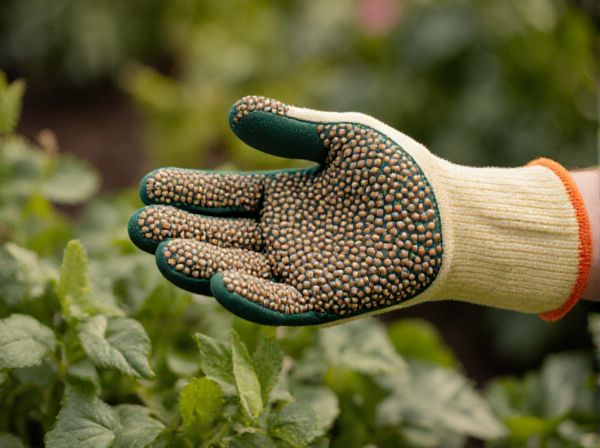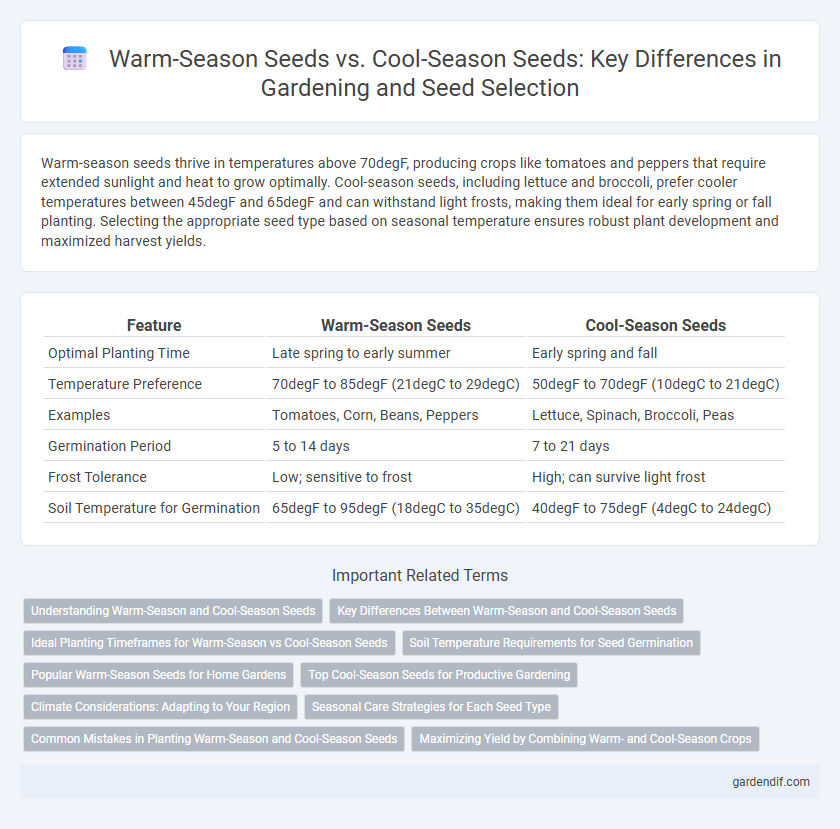
Warm-Season Seeds vs Cool-Season Seeds Illustration
Warm-season seeds thrive in temperatures above 70degF, producing crops like tomatoes and peppers that require extended sunlight and heat to grow optimally. Cool-season seeds, including lettuce and broccoli, prefer cooler temperatures between 45degF and 65degF and can withstand light frosts, making them ideal for early spring or fall planting. Selecting the appropriate seed type based on seasonal temperature ensures robust plant development and maximized harvest yields.
Table of Comparison
| Feature | Warm-Season Seeds | Cool-Season Seeds |
|---|---|---|
| Optimal Planting Time | Late spring to early summer | Early spring and fall |
| Temperature Preference | 70degF to 85degF (21degC to 29degC) | 50degF to 70degF (10degC to 21degC) |
| Examples | Tomatoes, Corn, Beans, Peppers | Lettuce, Spinach, Broccoli, Peas |
| Germination Period | 5 to 14 days | 7 to 21 days |
| Frost Tolerance | Low; sensitive to frost | High; can survive light frost |
| Soil Temperature for Germination | 65degF to 95degF (18degC to 35degC) | 40degF to 75degF (4degC to 24degC) |
Understanding Warm-Season and Cool-Season Seeds
Warm-season seeds thrive in soil temperatures above 70degF, promoting faster germination and robust growth during warmer months, while cool-season seeds prefer soil temperatures between 45degF and 65degF, ensuring optimal development in early spring or fall. Understanding the specific temperature requirements and growth cycles of warm-season versus cool-season seeds is crucial for successful planting and maximizing crop yield. Selecting the appropriate seed type based on regional climate and planting schedule enhances seedling vigor and overall garden productivity.
Key Differences Between Warm-Season and Cool-Season Seeds
Warm-season seeds, such as tomatoes and peppers, thrive in soil temperatures above 70degF and require longer growing periods with ample sunlight, whereas cool-season seeds like lettuce and spinach prefer soil temperatures between 45degF and 65degF and can tolerate light frosts. Warm-season seeds generally have slower germination rates and are sensitive to cold weather, while cool-season seeds germinate quickly and grow best in early spring or fall conditions. Understanding these temperature and growth cycle preferences is essential for optimizing seed selection and ensuring successful crop production.
Ideal Planting Timeframes for Warm-Season vs Cool-Season Seeds
Warm-season seeds such as tomatoes, peppers, and beans thrive when planted after the last frost date, typically in late spring to early summer, as soil temperatures consistently exceed 65degF (18degC). Cool-season seeds like lettuce, spinach, and peas perform best when sown in early spring or late summer to early fall, taking advantage of soil temperatures between 40degF and 75degF (4degC-24degC) before extreme heat or frost occurs. Understanding these ideal planting timeframes ensures optimal germination rates and robust plant development for both seed types.
Soil Temperature Requirements for Seed Germination
Warm-season seeds such as corn, beans, and tomatoes require soil temperatures between 70degF and 95degF for optimal germination, ensuring rapid seedling development. Cool-season seeds like lettuce, spinach, and peas germinate best in soil temperatures ranging from 40degF to 75degF, favoring early spring or fall planting. Proper soil temperature management significantly influences seed germination rates and subsequent plant vigor.
Popular Warm-Season Seeds for Home Gardens
Popular warm-season seeds for home gardens include tomatoes, peppers, and cucumbers, which thrive in temperatures between 70degF and 85degF. These seeds require full sun exposure and well-draining soil to ensure vigorous growth and high yields. Selecting varieties such as heirloom tomatoes or jalapeno peppers can enhance both flavor and garden diversity during the warm months.
Top Cool-Season Seeds for Productive Gardening
Top cool-season seeds for productive gardening include spinach, lettuce, and kale, which thrive in temperatures between 45degF and 75degF. These seeds germinate quickly in cooler soil, allowing gardeners to maximize early spring and fall harvests. Selecting high-quality seeds from trusted brands ensures robust growth and disease resistance in cool season crops.
Climate Considerations: Adapting to Your Region
Warm-season seeds thrive in temperatures between 70degF and 85degF, making them ideal for regions with hot summers and mild winters, such as the southern United States. Cool-season seeds germinate best in soil temperatures ranging from 50degF to 65degF, suited for areas with cooler springs and falls, including northern climates. Selecting seeds that align with the local climate ensures optimal germination, growth, and yield in home gardens and agricultural settings.
Seasonal Care Strategies for Each Seed Type
Warm-season seeds, such as corn and beans, require soil temperatures above 60degF for optimal germination and thrive in full sun with well-drained soil, benefiting from consistent watering to maintain moisture without waterlogging. Cool-season seeds, including spinach and lettuce, prefer soil temperatures between 40degF and 75degF and tolerate partial shade, requiring frequent watering and protection from intense heat to prevent bolting. Tailoring seasonal care by adjusting planting schedules and soil conditions ensures maximized growth and yield for both seed types.
Common Mistakes in Planting Warm-Season and Cool-Season Seeds
Planting warm-season seeds too early in cool soil can cause poor germination and seedling rot, while cool-season seeds sown in hot soil may fail to thrive or bolt prematurely. Neglecting to adjust watering schedules to the specific needs of warm versus cool-season seeds often leads to overwatering or drought stress. Using incorrect soil temperatures for germination decreases seed viability and delays growth, making it essential to verify optimal planting times based on seed type.
Maximizing Yield by Combining Warm- and Cool-Season Crops
Maximizing yield involves strategically planting warm-season seeds like tomatoes, peppers, and beans alongside cool-season seeds such as lettuce, spinach, and broccoli. This approach extends the growing period and optimizes space by leveraging the distinct temperature preferences of each crop category. Combining warm- and cool-season crops enhances overall productivity, ensuring continuous harvests and efficient use of soil nutrients throughout the year.
Warm-Season Seeds vs Cool-Season Seeds Infographic

 gardendif.com
gardendif.com